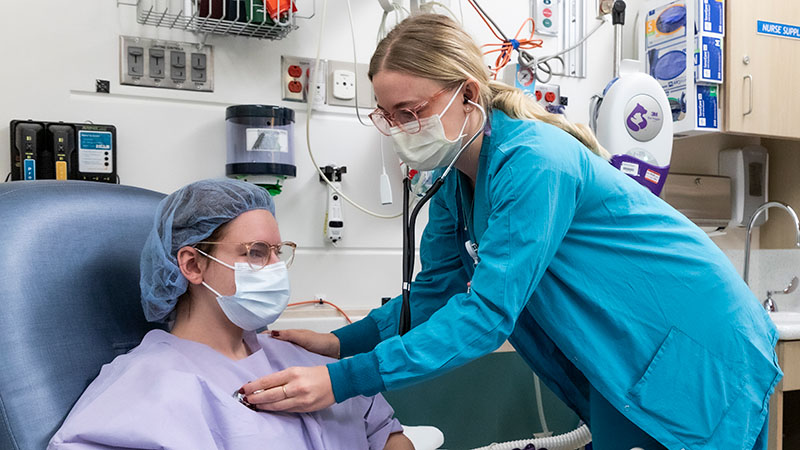Pyloric Stenosis
What is pyloric stenosis?
Pyloric stenosis (pronounced pie-LOR-ik sten-OH-sis) is a problem with a valve at the end of the stomach. Muscles thicken in the valve, which is called the pylorus. This can block or slow food passing from the stomach to the bowel. Doctors do not know why this happens.
Call your doctor right away if your child has forceful vomiting or signs of dehydration, such as peeing or pooping less than normal.
Symptoms of Pyloric Stenosis
All babies spit up or vomit from time to time. Babies with pyloric stenosis spit up more often and with more force. This is called projectile vomiting. Milk or formula spurts out with great force and may travel many feet.
Most often, babies with pyloric stenosis do not seem uncomfortable or sick except when they are vomiting. Vomiting may make your baby’s stomach hurt.
Over time, the problem gets worse. Your baby may:
- Be hungry all the time
- Have trouble keeping down any milk or formula
- Start to lose weight
Your baby may not have enough fluid in their body, a condition called dehydration. This can be deadly. Call your doctor right away if your baby has forceful vomiting or shows signs of being dehydrated:
- They may be sluggish and less active.
- The top of your baby’s head and their eyes may be sunken.
- Your baby may not pee or poop as often or as much as normal.
Pediatric General and Thoracic Surgery at Seattle Children's
Diagnosing Pyloric Stenosis
Babies with pyloric stenosis usually have a history of vomiting often and with force. Your baby’s doctor will ask you whether your baby has had symptoms of pyloric stenosis.
The doctor will examine your baby’s stomach to feel for the thickened muscle. Often, the muscle feels like a lump the shape and size of an olive.
-
Body imaging
The doctor may also ask for imaging tests to look at the muscle at the end of the stomach. This may help doctors find out whether your baby is vomiting for a reason other than pyloric stenosis. These imaging tests include:
- Ultrasound of the baby’s belly (abdomen). This is the most common test we do for pyloric stenosis.
- Barium X-ray. If we need to do this test, your baby will swallow a chalky liquid that helps the digestive tract show up on the X-ray.
-
Lab work
If the doctor thinks your baby may have pyloric stenosis, the baby will have blood tests to check the levels of electrolytes, such as sodium and potassium, in the blood. Frequent vomiting over a short time can cause an imbalance in electrolytes that must be fixed.
Treating Pyloric Stenosis
Treatment for pyloric stenosis is surgery called pyloromyotomy (pie-lor-oh-my-OTT-uh-mee). It lets food pass more easily out of the stomach.
-
Before surgery
Before the surgery, your baby will:
- Have blood tests to check that the electrolytes in their blood are in the right balance
- Get intravenous (IV) fluids to replace fluid lost from vomiting
To get enough fluid, your baby may need to stay in the hospital for a day or so before surgery.
-
Surgery for pyloric stenosis
Your baby’s surgeon will talk with you about the best type of surgery for your child.
- Most of the time, this surgery can be done through a few small cuts (incisions). This is called laparoscopic surgery.
- Sometimes surgeons use 1 larger incision. This is called open surgery.
At the time of surgery, we give your child medicine (general anesthesia) to make them sleep without pain. Our doctors are board certified, with extra years of training in how to give anesthesia to children safely.
During the procedure the surgeon makes a small, length-wise cut in the pylorus muscle to spread out the thickened muscle. The surgeon does not cut the inner lining of the passage, only the muscle around it. No tissue is removed.
The surgery takes 15 minutes to 1 hour. Your baby will be in the recovery room for another hour.
-
After surgery
After surgery, your baby will stay in the hospital for 1 to 2 days. During this time, your baby may still vomit a little as their body adjusts. This is normal.
We will give your baby:
- Pain medicine for comfort
- IV fluids until they can take enough formula or breastmilk/chestmilk by mouth
Your baby’s feeding will start slowly. At first, we give them watered-down formula or breastmilk/chestmilk. Each time your baby eats, we increase the amount and strength of feedings a little.
Your baby can go home as soon as they can eat regular formula or breastmilk/chestmilk and keep it down for several hours.
-
Home care and follow-up
Before your baby goes home, we will teach you:
- How to care for the incision
- About any medicine your baby may need
- Signs of problems to watch for
A surgery clinic nurse will call you 5 to 7 days after you go home.
- If all is well, you do not need to come back to the surgery clinic for a visit.
- If you or the nurse has any concerns about your child’s healing, we will set up a visit.
Babies with pyloric stenosis are usually fine once they recover from surgery and are eating well. They do not have a higher chance than other children of stomach, bowel or other problems later on.
Contact Us
Contact our Pediatric General and Thoracic Surgery Department at 206-987-2794 for an appointment, second opinion or more information.
To make an appointment, you can call us directly or ask your child’s primary care provider to refer you. We encourage you to coordinate with your primary care provider when coming to Seattle Children’s.
We have clinics in Bellevue, Everett, Federal Way, Seattle and Tri-Cities.
Providers, see how to refer a patient.

